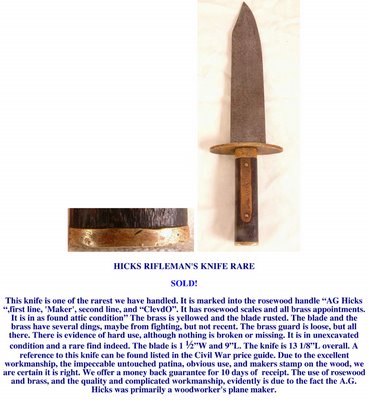 I've been chewing on the Hick's knife idea for some time now - to the extent that I wandered all over town looking for 1/16" X 5/8" brass, flat stock. I'm ready to bite the bullet but one question remains unanswered: A. G's ethnicity. It's either unimportant or I'll find out later. In any case his knives are interesting.
I've been chewing on the Hick's knife idea for some time now - to the extent that I wandered all over town looking for 1/16" X 5/8" brass, flat stock. I'm ready to bite the bullet but one question remains unanswered: A. G's ethnicity. It's either unimportant or I'll find out later. In any case his knives are interesting.
This example,at the top (from Wes Cowan's excellent website. I find lots of cool knives there) exploded my original thinking, based on the only other picture I'd seen thus far, I'd seen of his blades, that the guard/ferrule combination had been cast as a single piece. Reading the copy attached to the above photo, we have confirmed that he was a planemaker, and that goes some distance toward the why of the unusual construction he uses. Anyway, the brass fittings appear to be built-up from flat stock, which only makes sense, now that I think about it. A maker of handplanes would have little need to cast metals. Brass used there is mostly in the form of wear-strips.
For a little context, here's a jack plane from about the same period (1840"s). I bought this thing solely because it had a Butcher iron. I hoped to be able to build another plane around it. As you can see, the iron has been used to the point that a few more sharpenings are going to have eaten as far as the cap-iron, mounting slot. Ah well...
However, what I do find interesting is this: The plane is American. At the front it is stamped "(beat into illegibility by LOTS of hammer marks) Tool Co. New York". But the iron is English. Not too surprising for the period around 1830's-40's. The U.S. was producing steel at that time but not in the quantity or to the standards, of the products of Sheffield. There's a closeup of the iron trademark in the upper-left. "W. B. Butcher, Warranted Cast Steel, Sheffield, England". The question is this: If a period planemaker in New York state was using imported irons; would a colleague, in the wilds of Ohio, use anything but Sheffield blades for his Bowie knives? Not a big issue. I just like to be able to impart the appropriate level of crudity in construction.
As soon as I can get caught-up, I'd like to bang out a Hick's and see how it does on the website.










4 comments:
nike sb dunks
off white
kenzo clothing
golden goose sneakers
off white
yeezys
golden goose sneakers
curry 5
retro jordans
golden goose
p0s37o2w90 g7d98p9e20 l8b95k7j42 i7o26b0q44 x1q20c3o46 c6j12i0b62
goyard handbag
supreme new york
yeezy boost 700
jordan outlet
a bathing ape
kyrie 7 shoes
jordan sneakers
bape
golden goose sneakers
off white shoes
siiliaiao820
golden goose outlet
golden goose outlet
golden goose outlet
golden goose outlet
golden goose outlet
golden goose outlet
golden goose outlet
golden goose outlet
golden goose outlet
golden goose outlet
Post a Comment